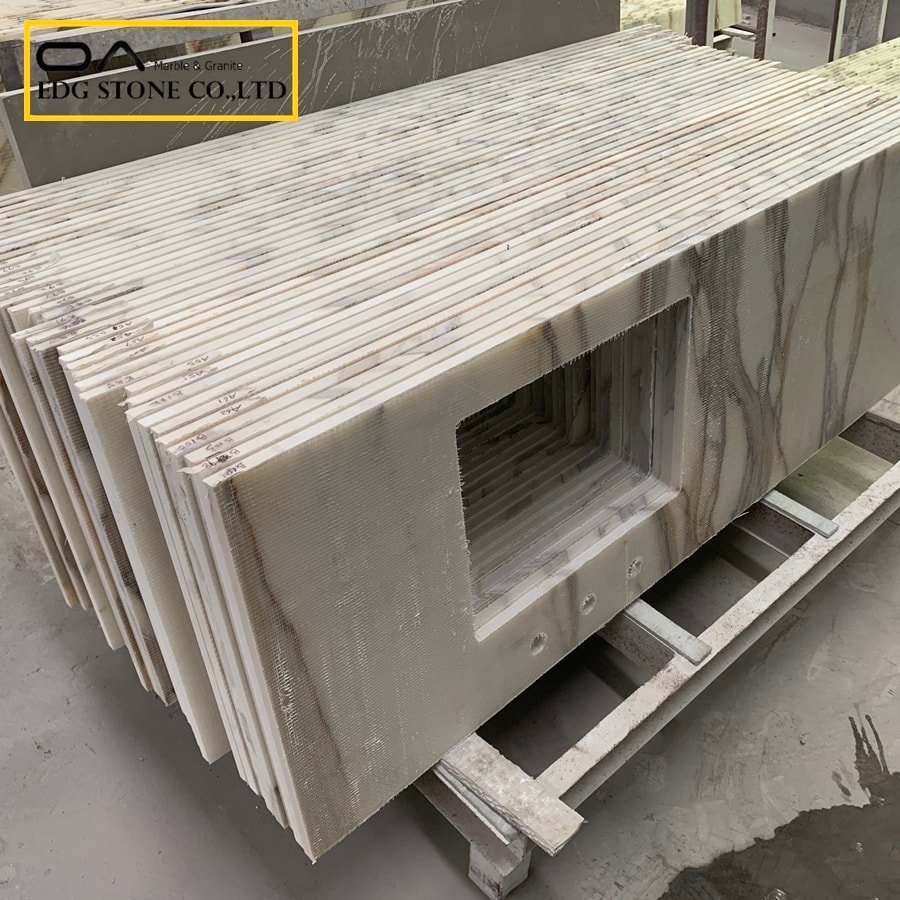
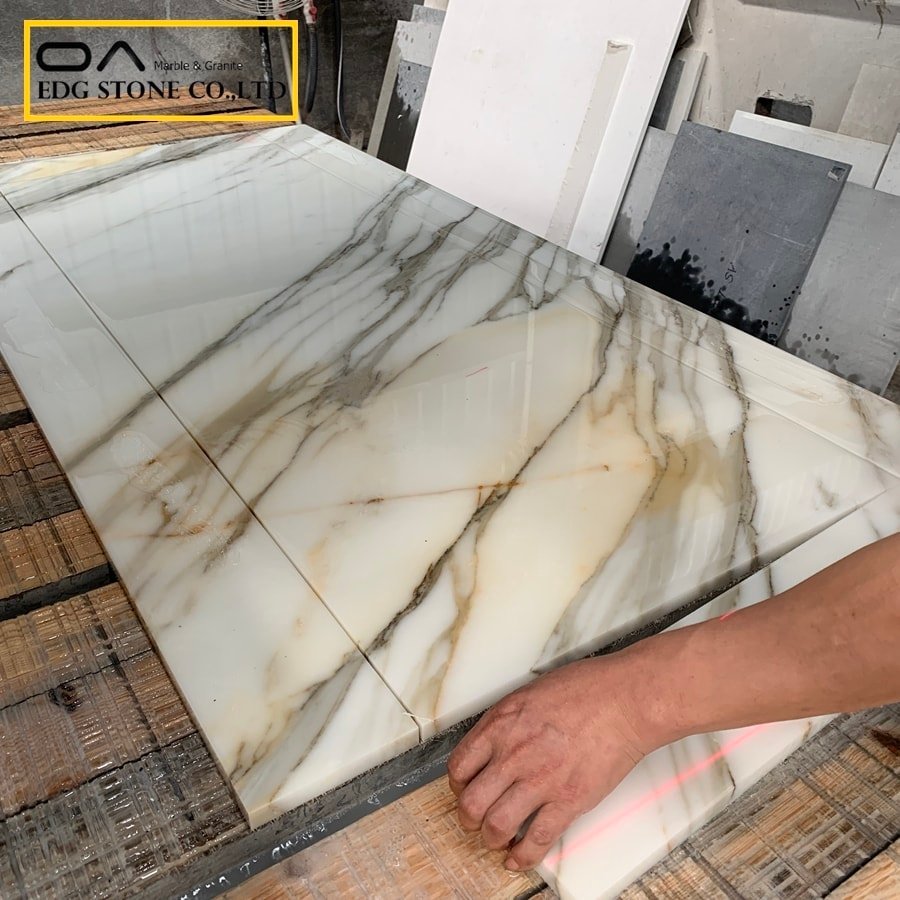
1 — Short definition (quick answer)
Table of Contents
Toggle- 1 — Short definition (quick answer)
- 2 — Where Calacatta comes from — origin & etymology?
- 3 — What Calacatta marble looks like & how to ID it?
- 4 — Popular Calacatta varieties: Gold, Oro, Viola, and others
- 5 — Calacatta marble vs. Calacatta quartz vs. quartzite — explainers
- 6 — Calacatta tile, slabs, and common applications
- 7 — Is “Calacatta white” the same as Calacatta?
- 8 — Cost, procurement, and buying tips (manufacturer/factory/wholesale)
- 9 — Maintenance, sealing, staining, and long-term care
- 10 — Is Calacatta out of style? Design trends & market signals
- 11 — Regulations and industry direction (OSHA silica, EU CPR, EPDs & sustainability)
- 12 — FAQ — Google hot questions (visible)
Calacatta marble is a family of luxury white marbles historically quarried in the Carrara/Apuan Alps of Tuscany, Italy. It’s characterized by a bright, near-white background and strong, dramatic veins that range from soft grey to gold, brown, and even purple hues depending on the variant. In trade, “Calacatta” is used as both a provenance label and a visual shorthand for that look.
2 — Where Calacatta comes from — origin & etymology?
Calacatta’s roots are regional: the Apuan Alps and Carrara area are the classic sources of Italy’s most celebrated white marbles. Over time, specific quarry families and blocks yielded visually distinctive white marbles; the trade adopted “Calacatta” (and commercial spellings like Calacata, Calacatta) to denote the brightest, highest-contrast varieties. Because marble is a natural material, names sometimes overlap or are used differently by suppliers — always confirm quarry provenance and slab IDs for high-value projects. ULTRA STONES – ULTRA STONESArchitectural Digest
3 — What Calacatta marble looks like & how to ID it?
Key visual cues:
Bright, luminous white field — often brighter than typical Carrara.
Bold, dramatic veins — veins tend to be thicker and higher-contrast; colors range from grey → charcoal → gold/brown and occasionally richer tones.
Large vein movement — sweeping arcs or strong linear flows make Calacatta visually striking.
Practical ID tips:
Ask suppliers for slab photographs and block IDs (quarry and lot).
Compare against Carrara (softer, greyer field and finer veining) and Statuario (refined but sometimes less dramatic than the boldest Calacatta variants).

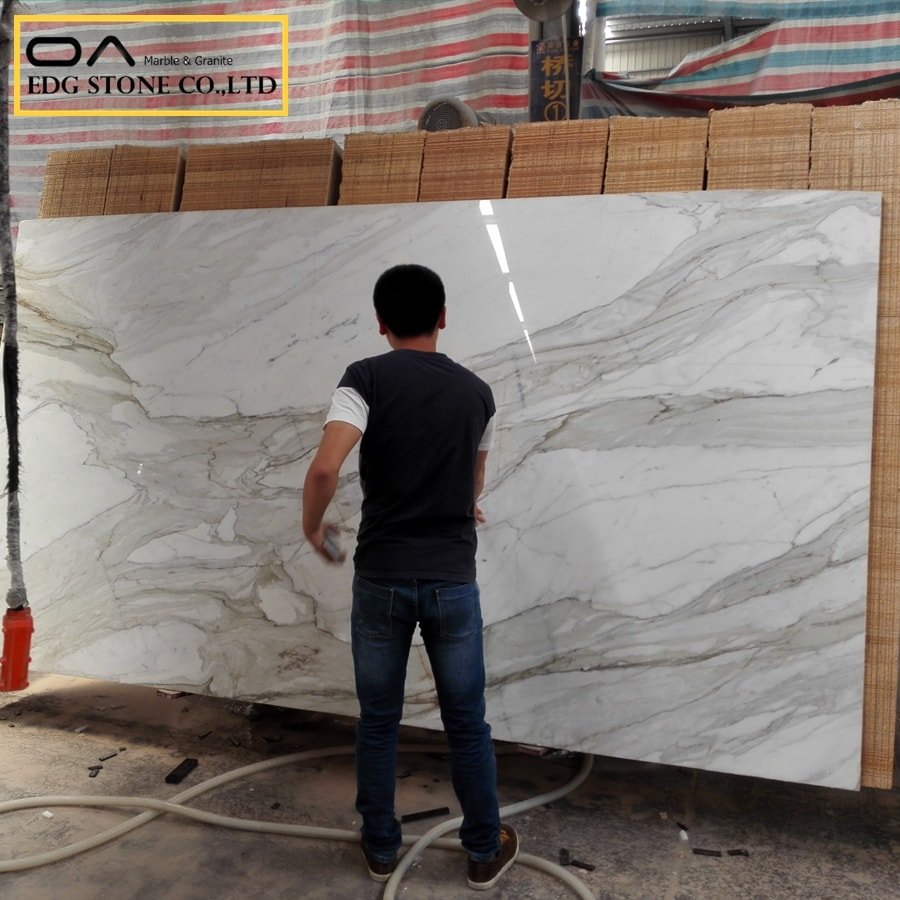
4 — Popular Calacatta varieties: Gold, Oro, Viola, and others
The trade distinguishes several commercially named Calacatta types; exact names vary by quarry/supplier, but commonly referenced variants include:
Calacatta Borghini — one of the most famous, often with bold grey to gold veins and strong contrast (highly prized).
Calacatta Gold / Calacatta Oro — white field with warm golden veins; frequently marketed as a premium decorative choice.
Calacatta Viola — notable for its striking purple/red-toned veins interspersed with white fields; popular for dramatic statement pieces.
Suppliers and tile makers often use these names as product labels; always request quarry provenance and slab photos when authenticity matters.
5 — Calacatta marble vs. Calacatta quartz vs. quartzite — explainers
Calacatta marble
Natural stone: metamorphosed limestone (mainly calcite).
Pros: Authentic natural variation, luminous appearance, high aesthetic value.
Cons: Porous, susceptible to staining and acid etching, requires sealing and careful maintenance for heavy-use areas.
Calacatta quartz
Engineered stone: primarily quartz aggregates bound with resin and pigments to mimic Calacatta marble.
Pros: Non-porous, low maintenance (no sealing), highly consistent, easier to source in matched runs. Often positioned as premium when veining is highly realistic.
Cons: Not natural; some purists prefer real marble. Pricing varies widely by brand/grade.
Calacatta quartzite
Quartzite is a natural metamorphic rock (not engineered) formed from sandstone. “Calacatta quartzite” is a trade name some suppliers apply to quartzites with a Calacatta-like appearance (white field with strong veins). Quartzite is generally harder and more scratch/heat-resistant than calcite marble, but the term “Calacatta quartzite” is a market label — verify the actual stone type with lab tests or supplier TDS.
When choosing, consider authenticity, maintenance expectations, and where the material will be used (island vs. prep counter vs. wall).
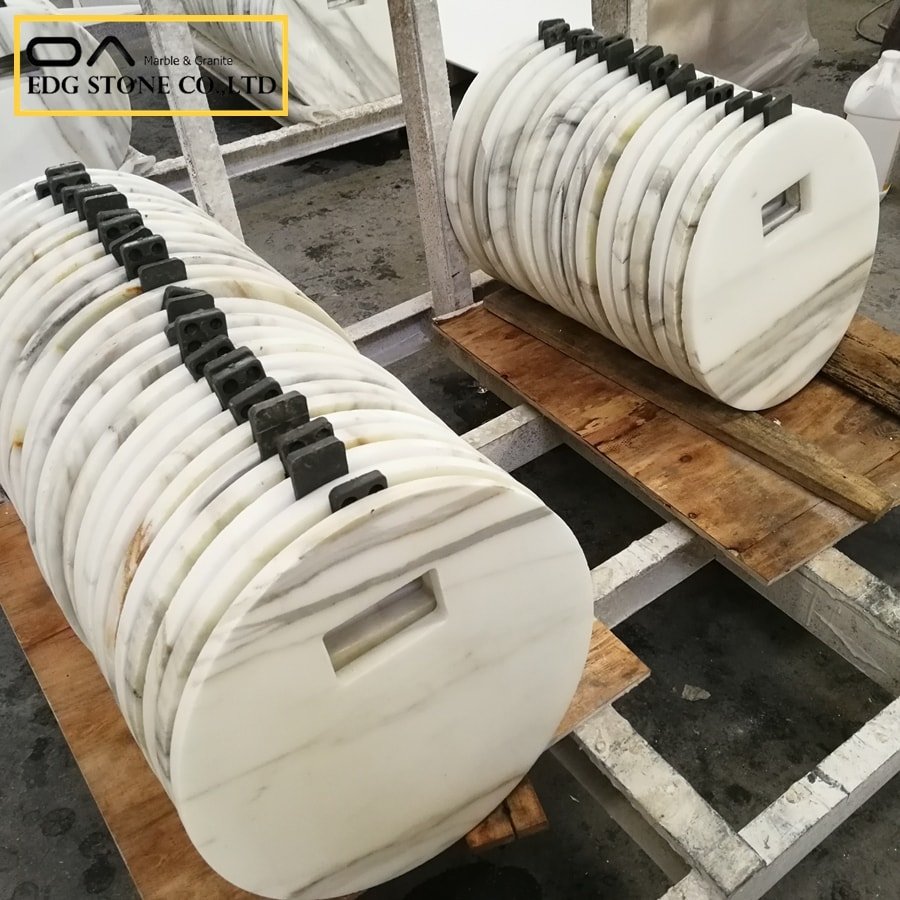
6 — Calacatta tile, slabs, and common applications
Calacatta is available in formats that include:
Full slabs (2 cm / 3 cm) — typical for countertops and large matched runs.
Tiles — porcelain/ceramic tiles printed to resemble Calacatta or thinner cut natural stone tiles for floors/walls.
Bookmatched panels — used for dramatic continuous veining across islands or wall cladding.
Common applications:
Kitchen islands and countertops (feature applications where the look is front-and-center).
Bathroom vanities and shower walls (paired with careful maintenance).
Lobby cladding, fireplace surrounds, reception desks, and hospitality feature walls.
Note: Natural marble slabs are heavy and may need reinforced cabinetry/substrates; porcelain slabs and engineered slabs are sometimes lighter and easier to adapt for vertical cladding.
7 — Is “Calacatta white” the same as Calacatta?
“Calacatta white” or similar phrases are often marketing names to emphasize the bright white field typical of Calacatta marbles. In practice, many vendors will use shorthand names—always confirm whether the product is natural Calacatta marble, engineered Calacatta quartz, or a porcelain/tile variant before purchase.
8 — Cost, procurement, and buying tips (manufacturer/factory/wholesale)
Cost signals: Natural Calacatta is often priced at the top of white marble ranges due to rarity and yield; engineered Calacatta quartz spans mid to premium price bands depending on brand realism and sheet size. Retail and installed pricing vary widely by market and project complexity.
Procurement checklist for B2B / wholesale / factories:
Ask for provenance and slab/block ID (for natural slabs).
Request full slab photos and joint layout plans for bookmatching and continuous veins.
Obtain technical documentation: TDS (technical data sheet), SDS (safety data sheet) for engineered products, and warranty terms.
Confirm lead times, MOQ, and palletization for factory/wholesale orders.
Get sample panels and, for large projects, order an extra slab for spares/repairs.
Negotiate shipping/insurance when importing heavy natural slabs—factor in freight, customs, and crating.
Use purchase-intent long-tail RFQs like: “Calacatta Borghini wholesale slabs direct from quarry,” “Calacatta quartz manufacturer factory price,” or “buy Calacatta tile wholesale.”

9 — Maintenance, sealing, staining, and long-term care
Natural Calacatta is calcite-based, so:
Sealing: Recommended—seal after installation and reseal periodically (frequency depends on use and sealer type). Sealing reduces liquid penetration but does not prevent etching (acidic reaction with calcite).
Staining & etching: Wine, citrus, and oil can stain/etch if left; immediate cleanup helps. Some homeowners accept a living patina; others prefer engineered lookalikes to avoid maintenance.
Cleaning: Use pH-neutral stone cleaners; avoid vinegar, bleach, or abrasive cleaners.
Repair: Chips and deep stains may require professional stone restoration.
If low maintenance is a priority, Calacatta quartz or sintered porcelain are practical alternatives.
10 — Is Calacatta out of style? Design trends & market signals
Calacatta remains a widely used luxury aesthetic: designers still favor bold veining and large-format, book-matched installations for high-visibility projects. That said, there’s a practical trend: designers often pair the Calacatta look for visual anchor areas and use more durable materials in heavy-use zones. Media and industry commentary reflect a nuanced position—marble continues to be iconic, while engineered and sintered alternatives gain share for resilience and sustainability.
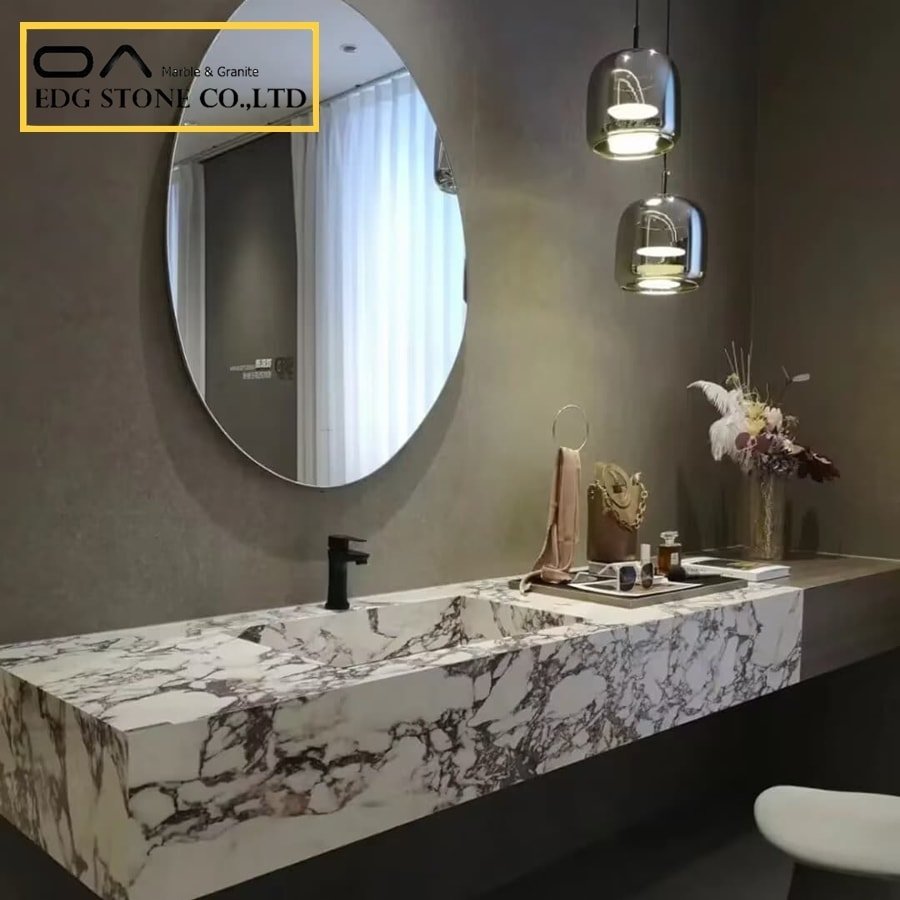
11 — Regulations and industry direction (OSHA silica, EU CPR, EPDs & sustainability)
Silica safety (U.S.): Cutting and grinding natural and engineered stones produces respirable crystalline silica. OSHA’s standards (e.g., 29 CFR 1926.1153 for construction) require engineering controls (wet saws, local exhaust), monitoring, and training—this increases fabrication costs and changes shop practices. osha.gov
EU Construction Products Regulation (CPR) & CE marking: Stone used as a construction product in the EU may require conformity documentation and CE marking depending on the application. Manufacturers selling slabs or cladding in the EU should verify CPR applicability for their product categories. https://www.appluslaboratories.comsingle-market-economy.ec.europa.eu
Sustainability & EPDs: Buyers increasingly request Environmental Product Declarations (EPDs) and supply-chain transparency. Engineered quartz producers are publishing EPDs for some products; natural stone provenance reporting and recycled content disclosure are also rising procurement requirements. These signals favor producers who can demonstrate lower embodied carbon or responsible quarrying.
12 — FAQ — Google hot questions (visible)
Q1: What is Calacatta quartz?
A1: Calacatta quartz is an engineered quartz slab manufactured to mimic Calacatta marble’s bright white field and dramatic veins; it offers a marble-like aesthetic with non-porous, low-maintenance performance.
Q2: What is Calacatta tile?
A2: Calacatta tile refers either to natural marble tiles cut from Calacatta slabs or to porcelain/ceramic tiles printed with the Calacatta look—used for floors, walls, and backsplashes where the pattern repeat and durability needs are considered.
Q3: What is Calacatta Gold / Calacatta Oro?
A3: Calacatta Gold or Calacatta Oro is a Calacatta variant featuring warm golden veins across a white field, widely used in design for a luxurious, warm marble aesthetic.
Q4: What is Calacatta Viola marble?
A4: Calacatta Viola is a striking Calacatta variant with richer purple/red-toned veins against a white field—used for dramatic, statement surfaces.
Q5: What does Calacatta marble look like?
A5: It typically shows a bright white background with bold, sweeping veins in grey, gold, brown, or purple—high contrast and dramatic movement distinguish it from softer Carrara marbles.
3–5 long-tail purchase-intent keywords:
“Buy Calacatta Borghini slabs wholesale direct from the quarry.”
“Calacatta quartz manufacturer factory price per slab”
“Calacatta tile wholesale porcelain Calacatta look”
“Calacatta Oro marble supplier bulk MOQ”
50 SEO tags:
calacatta, calacatta marble, what is calacatta marble, calacatta quartz, calacatta tile, calacatta gold, calacatta oro, calacatta viola, calacatta borghini, calacatta quartzite, what does calacatta marble look like, calacatta slab, calacatta countertop, buy calacatta marble wholesale, calacatta manufacturer, calacatta factory, calacatta wholesale, calacatta tile porcelain, calacatta gold marble, calacatta viola marble, calacatta white, calacatta oro marble, calacatta vs carrara, calacatta vs statuario, calacatta care, calacatta sealing, calacatta staining, calacatta maintenance, calacatta bookmatch, calacatta slab sizes, calacatta price, calacatta cost per sqft, calacatta procurement, calacatta EPD, calacatta silica safety, OSHA marble, calacatta CE CPR, calacatta design trends 2025, calacatta alternatives, calacatta quartz price, calacatta quartz manufacturer, calacatta porcelain slab, calacatta large format, calacatta high variation, calacatta installation, calacatta edge profile, calacatta polishing, calacatta restoration, calacatta wholesale slabs, calacatta supplier tips, calacatta buyer guide, calacatta showroom
